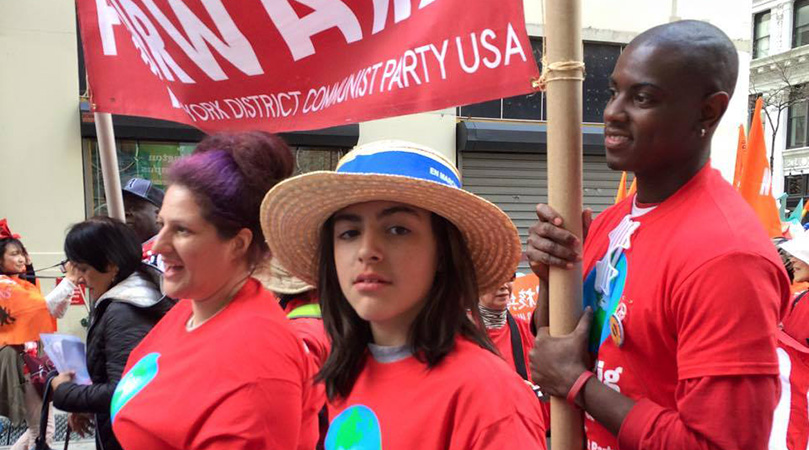
Joe Sims, who coordinates the CPUSA’s social media and party work couldn’t be happier. “In the past few years close to 5000 people have joined the CPUSA. Over 600 in the last two months of 2016,” he glowingly said. “Folks want to fight Trump.”
Like other groups on the left, the CPUSA is growing.
While Communists aren’t seeing the same kind of membership surge as Democratic Socialists of America (DSA), for example, their growth has been steady and increasing. Unlike DSA, however, the CPUSA doesn’t have the support of Sen. Bernie Sanders or well know celebrity personalities.
Most of the new members who joined through Facebook, the 60 year old New Yorker said.
“People come to us for different reasons,” Sims added. “Some are ready and willing to work, to help build coalitions, partner with unions, and deepen the discussion of socialism, but some also just want to register their protest against capitalism and that’s it, which is okay.”
“Increasingly, the question has become: ‘How do we engage these new members,’” Sims wondered out loud. “How do we incorporate them into our existing organizational structures, or create new structures to fit their reality, especially members spread out across the country.”
Interestingly, while the Party maintains long-standing organizational infrastructure and runs community centers in cities like New York, New Haven, Chicago, St. Louis, L.A. and Oakland, a large chunk of new members join from rural areas, not traditional Party strongholds.
Additionally, while the Party maintains a staff it does not have the resources to send organizers everywhere – especially into small towns.
“Nor should we try,” Nicholas James, added. James, a union representative in St. Louis, sees this upsurge as an “opportunity train a new base of ‘volunteer organizers.’” Besides being a union staffer, James also coordinates new member outreach for the St. Louis party.
“As a union organizer, I know how important it is to empower the membership, to give them responsibilities – with support – and then watch them blossom into activists,” James added. “The same holds true in the Party.”
James’ experiences, when it comes to Party members in unions, isn’t an exception either.
Unlike other groups witnessing an upsurge, the Party still maintains a considerable presence in a number of union locals, central labor councils and state federations. Its members often double as union organizers and officers, bargaining reps and shop stewards – which often leaves little time to talk about socialism, or challenge anti-communism.
Undoubtedly, the Communist Party is probably the most vilified organization in U.S. history. That it continues to attract members, in spite of this history, is a mystery to some, especially those on the right.
Its past association with Soviet Union isn’t a big problem anymore, according to Sims. “Younger people don’t carry that baggage,” he said.
One of the ways CPUSA maintains contact with new members, especially those who aren’t already part of an existing Party organization, is through national phone-banks, the most recent of which was held on Saturday, March 11.
In all, 34 Party members from across the country called a list totaling 4,767 new members. While roughly 2,200 calls were made resulting in 155 live conversations with new members, this is just a drop in the bucket.
“This is a great start,” Rossana Cambron, the Party’s national membership coordinator based out of L.A., said. “We have so much potential to grow. People are interested in socialism. And many of them want to make the Communist Party their political home.”
“We’ve just got to find a way to reach them, to provide them with organizing tools, and connect them to other activists – communists, union members, community leaders, people of faith, students, etc.”
While the bulk of the Party’s membership is concentrated in community clubs or Districts, Communists are increasingly using webinars, Skype, conference calls and social media to keep in touch with a growing, though politically inexperienced, base.
One example, is the Online New Members’ Collective, which meets every month to discusses ways of engaging the movement based on different experiences and organizational levels. Another is through the CPUSA Educational Commission, which hosts bi-weekly educational webinars.
Membership engagement, however, has always been an uphill battle for Party stalwarts and new members alike, as Communists tend to focus on building coalitions and unions, often to the detriment of the Party itself.
Regardless, as the Communist Party nears its 100th Anniversary in 2019, and as a new generation of members modernize the organization, one question remains constant: How to grow and consolidate the next generation of Communists?
“You don’t get to be 100 years old without carrying around some baggage,” Sims concluded. “But, our experience, our strategy and tactics, our coalition politics, as well as our many mistakes, put us in a unique position to grow, add to the democratic upsurge and help reshape our country.”
“I’m optimistic,” Sims added with a smile.


 Join Now
Join Now